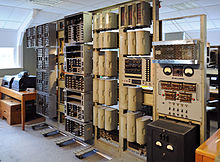The National Museum of Computing
 Entrance sign |
|
| Data | |
|---|---|
| place | Bletchley |
| Art |
Computer Museum
|
| opening | 2007 |
| Website | |
The National Computer Museum ( english The National Museum of Computing in short TNMOC ) of the United Kingdom dedicated to the preservation and public presentation of historical calculating machines , especially the tube computers from the 1940s. It opened in 2007 and is located on the grounds of Bletchley Park in the English city of Bletchley, about 70 km north-west of London .
Visiting hours
The museum is regularly open in the afternoons on Thursday, Saturday and Sunday and on public holidays. Guided tours are mostly offered on Tuesdays or, for groups by special agreement, on other days as well.
The focus of the museum is naturally on British mainframes . According to its own information, the TNMOC houses the world's largest collection of functional historical computers . The public is presented with the wide range of developments from the highly secretive beginnings in the 1940s through the following decades to the 1980s and beyond. Training seminars and programming courses are also offered for all ages.
Tunny
Together with the Colossus Gallery , the Tunny Gallery is one of the showpieces of the museum. An important part of the war history of the United Kingdom that has long been top secret is illustrated here . It is about the successful break of the top secret strategic communication of the German armed forces in the Second World War . This used for their telex network, with which the highest command authorities, such as OKW and OKH , with the Army High Command (AOK) in cities such as Vienna, Rome, Paris, Athens, Copenhagen, Oslo, Königsberg, Riga, Belgrade, Bucharest and Tunis were connected. a key addition specially developed by C. Lorenz AG in Berlin . To decipher this Lorenz machine , British code name Tunny (" tuna "), the British developed an electronic replica of the key addition, which emulated (imitated) the functions of the German machine , but worked differently and looked completely different. He was also known as the British Tunny . A replica true to the original is on display in the museum.
Colossus
The museum's collection also includes a true-to-original replica of the world's first tube computer Colossus . The original, like the Tunny machine, was designed by British cryptanalysts and engineers during the Second World War and built in several pieces. Colossus was especially used by the British to decipher the Lorenz machine . Immediately after the war, all original Colossi were dismantled and destroyed for reasons of secrecy. It was not until the 1970s that its earlier existence became public. Twenty years later, the Briton Tony Sale decided to rebuild a Colossus for the museum in Bletchley Park and he launched the Colossus Rebuild Project (German: Colossus Reconstruction Project). He and his team succeeded in recreating it after several years of intensive work and on June 6, 1996, the replica Colossus finally had its first successful test run. For the official inauguration of the replica on November 16, 2007, German radio amateurs radioed a ciphertext encrypted with an original Lorenz machine . The British received the radio message in Bletchley Park and Colossus " cracked " the message in three hours and 35 minutes. It contained an invitation to an exhibition with historical computers in the Heinz Nixdorf MuseumsForum in Paderborn . The replica Colossus is on display at the Bletchley Park Museum.
Harwell computer
Another showpiece of the collection is the oldest still functional digital computer in the world. This is the Harwell computer , also known as WITCH (short for Wolverhampton Instrument for Teaching Computing from Harwell ). It was originally put into operation in 1951. Since 2012, after three years of restoration, it has been ready for use in the TNMOC exhibition. He uses relays for the arithmetic unit and counters .
See also
Web links
- Official website (English)
Individual evidence
- ↑ TNMOC WebSite (English). Retrieved January 23, 2017.
- ↑ About us self-description (English). Retrieved January 23, 2017.
- ↑ Donald Michie : Colossus and the Breaking of the Wartime "Fish" Codes. Cryptologia , 26: 1, pp. 17-58, 2002. doi: 10.1080 / 0161-110291890740 . DOC; 220 kB.
Coordinates: 51 ° 59 ′ 54.6 " N , 0 ° 44 ′ 36.6" W.


